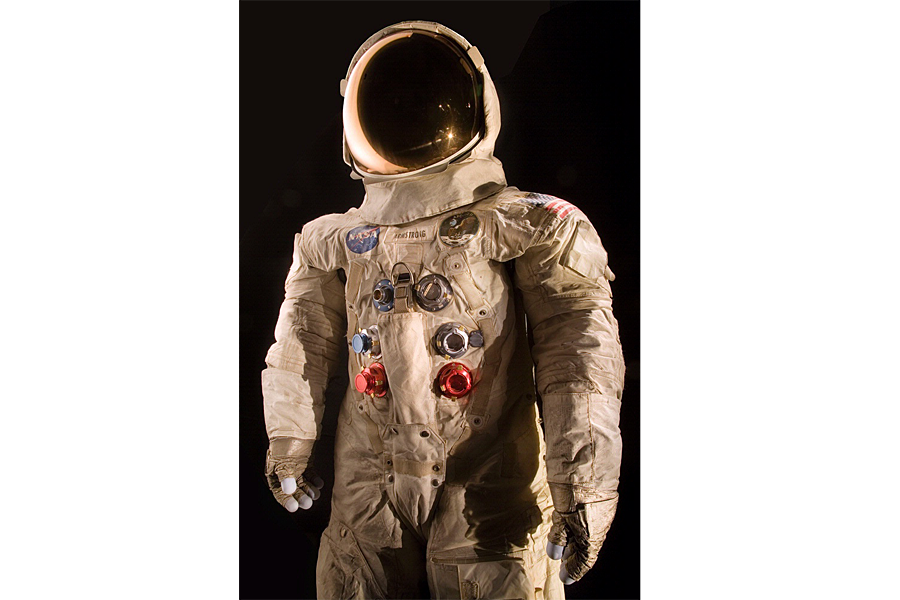Smithsonian turns to Kickstarter to preserve Neil Armstrong's spacesuit
Loading...
Preserving the spacesuit worn by Neil Armstrong on the may require one giant leap for crowdfunding kind.
The Smithsonian Institution has launched a "Reboot the Suit" campaign on the crowdfunding platform Kickstarter to raise money to preserve, display, and digitize the iconic A-7L pressure suit worn by Cmdr. Armstrong during his walk on the lunar surface 46 years ago on Monday.
This National Air and Space Museum project, run as a partnership between the larger Smithsonian Institution and Kickstarter, also marks a new direction for museums and other cultural institutions which are hoping to gain funding via a series of campaigns in partnership with the website.
Kickstarter has helped raised money for a host of scientific and museum partnerships, such as Ai Weiwei at the Royal Academy of Arts in London (live right now), +POOL, which plans to build a floating pool in NYC's East River, Bill Nye’s LightSail from the Planetary Society, and Andrew Kuo at the Museum of Contemporary Art Detroit. The Smithsonian's campaign is Kickstarter's biggest one yet.
“I would say this is the most significant partnership in this direction we have had to date,” says Kickstarter Spokesperson David Gallagher in an interview. “We’re working with the larger Smithsonian institution. This is the first time we’ve had a large partnership around a series of projects.”
According to the Smithsonian’s Director of Digital Philanthropy, Yoonhyung Lee, in an interview, “From our perspective, the series is very important aspect for us because we can go back to the Kickstarter platform to tap this audience, again and again, where they already are, instead of trying to force them into traditional fundraising channels is very appealing to us.”
“We have been talking to Kickstarter for a long time and this is the first thing that really felt right for us,” Ms. Lee adds. She says the other fundraisers in the series have yet to be defined.
Mr. Gallagher adds, “During this pilot year, the focus will be on artifacts, exhibitions, and projects that need funding, giving the public a variety of opportunities to support the Smithsonian based on their own interests.”
This inaugural project by the Smithsonian to support the National Air and Space Museum seeks $500,000 to restore, preserve, digitize, and exhibit the suit.
Funding on Kickstarter is all-or-nothing. If the project succeeds in reaching its funding goal by a certain date, all backers’ credit cards are charged at that time. If the project falls short, no one gets charged.
Backers of the project receive rewards ranging from items such as a Neil Armstrong Spacesuit mission patch to a 3-D print of his glove to an opportunity to meet an astronaut.
Does this mean that smaller projects on the site will suffer, being unable to compete with a behemoth that can offer “A Night at the Museum,” (donations of $1,969), or “A Smithsonian flag that flew on Space Shuttle Discovery” (donations of $2,500 or more).
“There’s no sign that says ‘You must be this tiny to use Kickstarter’,” says Mr. Gallagher in an interview. “We’ve found that larger projects like this can bring in new people to Kickstarter who then go on to find other projects to back. Often those are smaller projects. You hear about this, you start seeing our newsletters and seeing these other projects we highlight and you might dive in and support it.”
Overall, Gallagher says that Kickstarter is successful in large measure because it “creates a community” of backers and project developers that crosses over into long-term social, moral, and financial support.
“It’s not just about raising money, but about gathering a community around an idea,” Gallagher says. “A lot of people come to us and say ‘I was raising funds for something but I came away with this group of people who are my supporters and my fans who want to stay on top of what I do next.’ There’s a sense of ownership there. You get involved and feel like you had a part in making this thing happen.”






